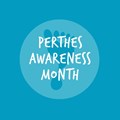Story
Perthes disease or Legg-Calve-Perthes disease as it is sometimes known, is a rare childhood condition that affects the hip. The blood supply to the hip bone is disrupted, causing bone cells to die, which erodes the hip and causes pain in the process.
Perthes is approximately 4 times as common in boys as girls and generally occurs between 4 and 8 years of age. Active children tend to be more affected. The first symptom is usually a painless limp, but symptoms can be very subtle, with a mild ache in the thigh or knee not being uncommon.
Unfortunately medical agreement on the best way to treat Perthes has not yet been reached. It is treated in various ways but pain management remains a key issues faced by many children. At times, parents are told to "wait and see" to enable the doctors to assess how to best treat their child's condition.
As the condition is not well known, it could occur that the child is not correctly diagnosed with Perthes disease leaving the hip to erode resulting in an odd shape. The effects of Perthes into adulthood are still very much unknown. Doctors have very limited information on how many adults require a hip replacement (if any) and if the disease has had long term consequences on their daily activities.
We want to change this and support more awareness and research into Perthes disease and find the best way to diagnose and treat children. Help us to fund more awareness and research and support families and adults impacted by the condition.
How can you help us? It very simple, pick an activity during the month of October and set yourself a goal. It could be to score 100 goals in a week or to swim 100 lengths in a swimming pool. Whatever you decide to do, remember you are doing it to support children and adults impacted by Perthes.
 Campaign by
Campaign by 